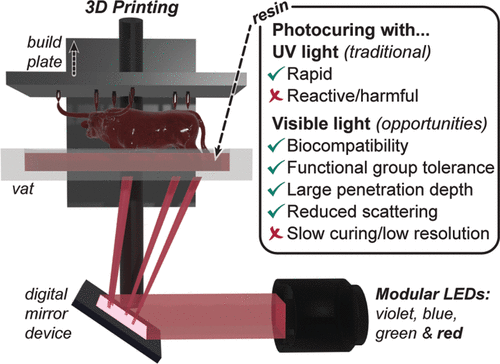Scientists develop practical new 3D printing resin optimized for visible light
One method of 3D printing is to selectively expose liquid resin to ultraviolet (UV) light to harden the resin into a solid. Now, scientists
have developed a new resin that can use safer and more energy-efficient visible light. Although visible light can already be used on
photosensitive resins, the hardening process is quite slow, so it is not practical in actual use. Ultraviolet light works much faster, but its
energy requirements-so its cost is much higher.

In addition, excessive ultraviolet rays may harm biological tissues. This means that it cannot be used for bioprinting of tissues contain
living cells, nor can be used for printing internal structures of the human body. Ultraviolet rays cannot penetrate the resin like visible
light, and it also scatters more. Considering these limitations, researchers from the University of Texas at Austin have developed a
new resin, which consists of monomers, photo-oxygen catalyst (PRC), two co-initiators and an opaque agent. composition.
The PRC absorbs the visible light of the LED on the printer, which promotes the transfer of electrons between coinitiators. This in
turn causes the monomer to polymerize (harden). Opacifiers help to limit the process to areas exposed to light and improve printing
resolution.
The fastest printing speed of 1.8 inches (46 mm) per hour is practical for small items, but it still less than half of the maximum speed
of UV printing. In other words, this number can be increased by increas the intensity of visible light or adding additional compounds
to the resin.
- What are the key points of choosing dental 3D printer?2020-07-28 16:55:35
- How to rent and purchase dental 3D printers2020-07-28 16:57:00
- What are the key points of choosing DLP 3D printer?2020-07-28 16:58:46
- 3D printing helps the digital transformation of the dental industry2020-09-22 09:00:50
- Mechanical problems of z-axis instability in LCD 3D printing2020-09-07 15:13:43
- The world’s first case of four bionic cat paws, amazing my 3D printing2020-09-07 15:03:32
- The same is an industrial 3D printer, where is the difference between "they".2020-08-29 09:04:32
- 4 ways to solve the problem of "level stratification"2020-08-13 10:35:22
- Understand the "kelp" in light-curing 3D printing (sheet/floc)2020-08-13 09:31:29
- Born specifically for designers, the new 3D printer Stratasys J826™ is available!2020-08-03 15:59:50
- Nature: Electrostatic jet deflection 3D printing sub-micron structure, the speed is 1,000 to 10,000 2020-08-03 15:04:17
